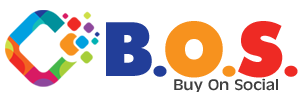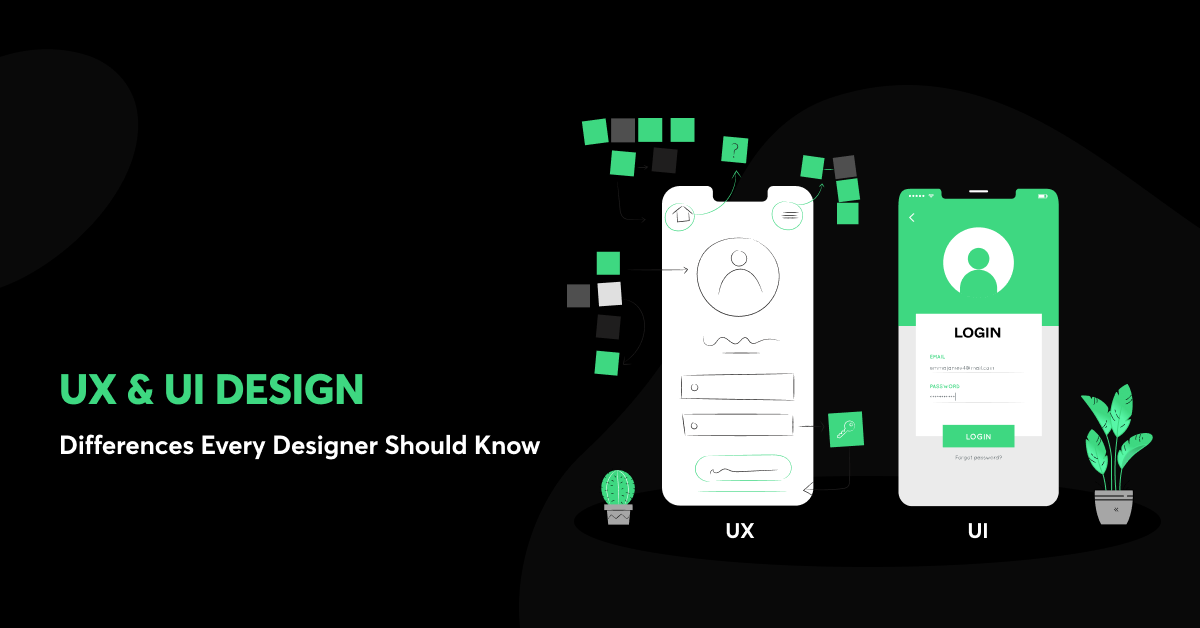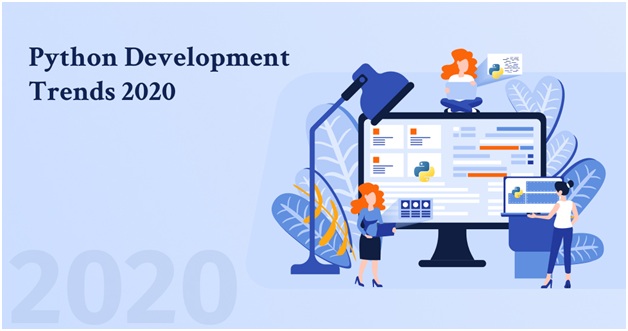UX & UI Design: Differences Every Designer Should Know
November 5, 2020When it comes to product design, we sometimes hear the terms User Interface (UI) and User Experience (UX). In digital product design, these terms are popular for people who leverage UX/UI design and development services that every designer should know. Well, you’ve come to the right place. This article will help you in understanding about what UX and UI mean and how they differ.
Table of Contents
What is UI?
A key aspect of human-computer interaction is the UI (User Interface). It’s where human and computer interactions take place. The purpose of the interaction is to enable the computer from the human end to be operated and controlled successfully.
The appearance and layout of the UI design are based on how every aspect of the product looks, including buttons, placeholders, text, images, checkboxes, and any elements of the visual interface that users interact with. UI mostly focuses on the visual aspects of a product to make the websites, apps, plugins, themes, etc. look absolutely stunning and elegant while also being accurately usable to the user.
What is UX?
UX (User Experience) is the overall experience a user has with the products or services of a company. The design of an excellent and horrible user experience is controlled by how seamless or challenging it is to interface with some element or aspect of a product or service.
In order to understand things such as customer problem areas, possible market gaps, and competitor analysis, UX design mainly involves research. In addition to focusing on a deep understanding of users and overlooked market needs, UX also considers the business priorities and goals of building products that comply with the visions and missions of the company. UX best practices enhance user interactions and, as required, the company’s vision of products and services.
What’s the difference between UI and UX?
UX design actually refers to the design of the user interface, and UI design refers to the design of the UI. In product design, they have a friendly relationship but serve multiple roles. In addition, when it comes to functionality, UI is the way things look, UX is the way things work. User Experience is a process, while a deliverable process is the User Interface. However, because they appear to have a symbiotic relationship, people essentially confuse the two.
Now, let’s go through the three most essential differences between UI and UX, every designer should know.
1. Different Focus:
There is an alternative use of UI and UX designers for prototyping. Numerous UI designers assume that a hi-fi model should be a prototype. Likewise, fidelity is a reconsideration for the UX designer because they think more about the rationale. For example, show your customers the design made by the UI designer when you meet them, and when you meet the software programmers, take the prototype made by the UX designer.
Also, the explanation is truly logical. UI designers pay more attention to the interface, to the front end, while UX designers focus on the back end.
2. Colours Utilization:
In general, UI designers will have full-colour prototypes. Alternatively, UX designers often use only three colours in the model plan which are black, white and grey.
In general, this difference can be seen in designing and using icons. For example, UI designers can burn through plenty of effort when you need to build a bottom navigation bar, making it as sensible as can be anticipated under the circumstances, including the colouring of the button when pressing. UX designers will actually embed the button in the perfect spot, leaving a note at that point: grey after clicking.
3. Tools Utilization:
Designing images is of prime significance for UI designers. Therefore, tools such as Flinto and Principle, restricted to Sketch, have a benefit. InVision is also an option which makes it a serious choice for the team coordination function.
As wireframe saves time and makes designing more efficient, every designer should know that UX designers will support it. For example, there are several qualified prototyping tools such as Mockplus which provide a simple and transparent process, Balsamiq with sketch style, and Axure with full functions. There is, however, a particular benefit of using Mockplus, as it has 8 different ways to test projects and to preview them.
How do UI Design and UX Design work together?
UX and UI go immovably inseparably and, bearing in mind that with one and not the other, there are a large number of examples of extraordinary products, imagine how much more efficient they might have been in both fields when solid.
Powerful website design blends UX and UI together. Every designer should know that UX design will be understood and acknowledged by a decent UI designer, and vice versa. Definitely, UI design is currently observed by different experts as a component of user experience design. Both the way a visitor feels when viewing your content and the way your branding is portrayed have an effect on the overall user experience. Bad visuals, poor copy, and a congested design will discourage people from using your website to follow a route.
UX design integrates the architecture of content strategy and information. This covers all of it from which content goes to conversion forms, what your CTA buttons are copying from, scrolling vs. clicking. UI design ensures that your brand message translates into the design and that the persona of your company is relying on your website.
Which is the best fit, UI or UX?
Well, it’s mostly based on you. A UX designer and UI designer both focus on designing amazing interfaces, but during the design and development process, their input and ranges of skills are required in multiple situations.
The UI manages UI tools or software to design a visual UI solution and the majority of the user experience manages the simplicity of playing out the activity or the experience managed while utilizing the product.
Things about UX every designer should know:
UX designers concentrate on creating the structure, flow, and functionality of a product. However, they work hand in hand with marketers, industry analysts, and product teams to comprehend customer preferences.
In the aftermath of defining the target audience and their objectives, UX designers evaluate market data, look at benchmarks, and guide user testing and competitor analysis to create solutions that boost the user experience at every step.
In the aftermath of discussing and managing the designs for UI designers, UX designers will remain and proceed to consult on the project.
Things UI designers keep in mind:
Together with UX designers, UI designers analyze the layout and design of a project. UI designers make high-constancy layouts utilizing visual identity, style guides, and UI kits with sensitive guidelines, and then identify animations and transitions.
UI designers make comprehensive style and reference guides to assist developers with understanding the project. During the development process, UI designers closely work with the developers to test and give feedback on the product before completion of the final version.
As a rule, every designer should know UX designers will be responsible for a definitive consequence of the project. They will closely coordinate and monitor the work of UI designers and developers in order to make sure that the final products are exactly what their audience wants.
By leveraging the services of UX/UI development companies, developing prototypes will eventually get the design and engineering teams on the same page and improve the design-development process. In addition, prototyping will allow the design team to use HTML and CSS without figuring out how to code. In addition, developers can create interfaces built with spotless, semantic code, based on perfectly functioning prototypes.
Conclusion:
In the app and web development process, UI/UX Design and Development go hand-to-hand, but they are separate entirely. UX design is more systematic because It is established in cognitive behavior and human psychology. Every designer should know UI design relies significantly more on visuals, irrespective of whether a product is aesthetically pleasing.
It is important to identify the type of design that you typically find fascinating and concentrate on supporting the skills to produce exceptional design solutions. If you’re new to the world of design, we suggest that you explore both areas for yourself. In both areas, not only does realistic real-world experience help you to understand which area is better for you, but will also make you a better designer.




I don’t think the title of your article matches the content lol. Just kidding, mainly because I had some doubts after reading the article. https://www.binance.info/pt-PT/join?ref=V2H9AFPY
Greetings! Very helpful advice in this particular article!hipica tv
Pretty! This has been a really wonderful post.any thanks for providing these details.Live TV
Some really excellent info Sword lily I detected this.-vox live kostenlos
Good post! We will be linking to this particularly great post on our site.Marchul Tilted Cat Food Bowl with Feeding Mat for Food and Water Food Feeding Dishes for Raised Cats and Puppies – Hot Deals
I very delighted to find this internet site on bing just what I was searching for as well saved to fav . – boys hey dudes
Your article helped me a lot, is there any more related content? Thanks!
Wow, incredible weblog structure! How long have you been running a blog for?
you made running a blog look easy. The overall look of your
web site is wonderful, let alone the content material! You can see similar here sklep internetowy
As I website owner I believe the content material here is really good appreciate it for your efforts.